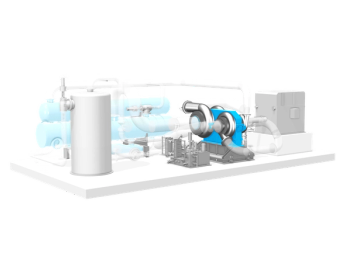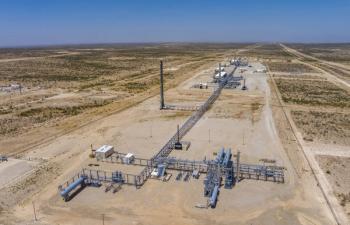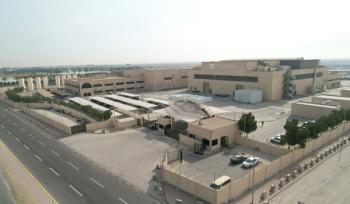
Dresser-Rand compressor operating conditions
In a paper, "Buying and Selling #1," authors Harry Miller and James Soroakes of Dresser-Rand and Michael Drosjack, a consultant, outline the challenging operating conditions encountered by today's compressors.
(Sour gas Shah Field in Abu Dhabi)
In the paper presented at the 40th Turbomachinery Symposium in 2011, the authors say that many of the compressors supplied today are often the first one for that particular application. Earlier, these compressors -- called Serial Number One machines -- were a rarity. Among the changing compression requirements being raised by the end users to the manufacturers are:
Acid Gas
Over the years, fields with high concentrations of acid gas were often bypassed because there were poor economics to producing them in comparison to fields with little or no acid gas. SERIAL NUMBER ONE compressors were needed which would be expensive to develop and build. And, the produced hydrocarbons might have their value debited from the presence of acid gas contamination. Thus, when these fields had been discovered in the past, they were usually bypassed and left in place. Demand and supply conditions have changed so that these fields now need to be produced. H2S concentrations of as high as 40% are showing up on data sheets.
In many of these fields, the compression services are being used to re-inject the gas after liquids are removed. One of the many problems with these services is the required material properties of the compressor construction. These require exotic materials which are often more difficult to obtain, form, and are always expensive. In addition, some of these conditions are new to the designer and determination of true material properties under operating conditions might require difficult and expensive testing.
But ACID GAS is here. A great example is the Shah Field in Abu Dhabi located about 111 miles (180 KM) southwest of Abu Dhabi in the UAE, holds 200 trillion cubic feet (5.7 trillion cu.m.) of gas some or mush of which is sour. An investment of $10 billion is expected to recover and process the gas.
Multi-Phase Flow
Multi-phase operation requires a compressor to move a combination of gas and liquid. As long as the gas volume fraction is in excess of 90%, this can be done with more conventional equipment. However, that limit is being severely pushed. In subsea applications, separation vessels can be outrageously expensive, especially in deep water where pressure ratings of vessels may be 10,000 psi or 15,000 psi (700 bar to 1,000 bar). On platforms, separation vessels cost a penalty in both weight and footprint. In many applications, separation also requires parallel gas and liquid lines which can add greatly to the complexity and cost. In viscous crude applications, multiphase pumping can be more efficient since the gas acting as a significant friction reducer. And, in most applications, separation will lead to additional hardware costs and considerably more complexity to the configuration. In a number of the newer developing fields, the relative amount of gas on oil are not yet well understood and will change (often dramatically) over the life of a field.
Very Large Sizes and Capacities
LNG and Ethylene processes are relatively mature processes that may not have a lot of opportunity for process breakthroughs which increase the margins in these largely commodity businesses. One of the remaining means to increase margins and profitability is through economies of scale. These have led to increasing demands on the capacities of the compression trains in these facilities.
High Pressure
Higher pressure fields are being pursued at an increasing rate in many parts of the world, e.g., Kazakhastan, Indonesia, Oman. Injection services have climbed to 500 bar (7,250 psi) and as much as 800 bar (11,600 psi) requirements. These are considerable step-outs from more conventional pressures.
New Processes
GTL (Gas to Liquid) plants are being proposed and built on a very large scale. These facilities require very large air separation facilities. The GTL processes are exothermic but produce mediocre quality steam which must be consumed. Very large air compressors, greater than 80 MW (100,000 bhp) are being employed driven by steam turbines powered by 175-250 psi (12-17 bar) inlet steam to drive these machines.
Subsea
There is a desire and, in some cases, a requirement for turbomachinery to be deployed on the bottom of the sea in water depths of over 2000 meters (6,500 ft). This requires very high pressure casings, seal-less machines with electric motor drives, product lubrication (or a sophisticated composite system), and a footprint and weight that are manageable in these services. In addition, there is an extraordinarily high cost for intervention (maintenance) which drives the need for very predictable mean time between maintenance of the compressors and all their supporting systems.
Seal-Less Compression
Above and below the water, there is a growing desire for seal-less compression. Drivers are weight and footprint limitations and the desire to limit the complexity of the overall system configuration. There is also a strong desire in hazardous services to positively contain the process fluids without the peripheral sealing devices that can add greatly to the likelihood of a loss of containment. Subsea compressors, by their nature are seal-less.
Limited Definition of Process Fluids or Process Requirements
Many of these services are operating well outside the "normal" boundaries of past experience. As such, it may be found that the properties of the fluids being moved are not well defined in all the ranges of operation. Gas property models may not have been established for the extremes of operation being required. In some cases, typical property models may not be sufficient and process simulations may be required. An example is the performance of high pressure CO2 with the presence of some water. Material properties may also not be well defined in some of the extreme range of operations. Finally, the definition of the process requirements in some of these applications may not be understood with a high level of accuracy. The performance of many of the "extreme" oil and gas fields must be extrapolated as there is very limited or no prior performance history from those fields.
Newsletter
Power your knowledge with the latest in turbine technology, engineering advances, and energy solutions—subscribe to Turbomachinery International today.




